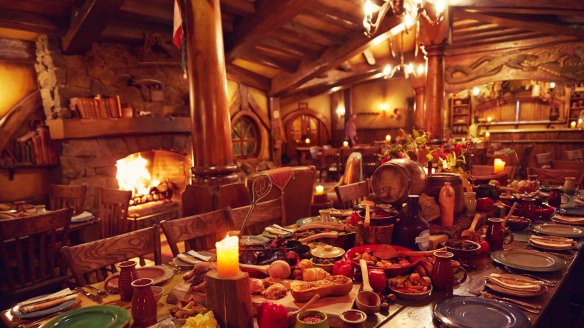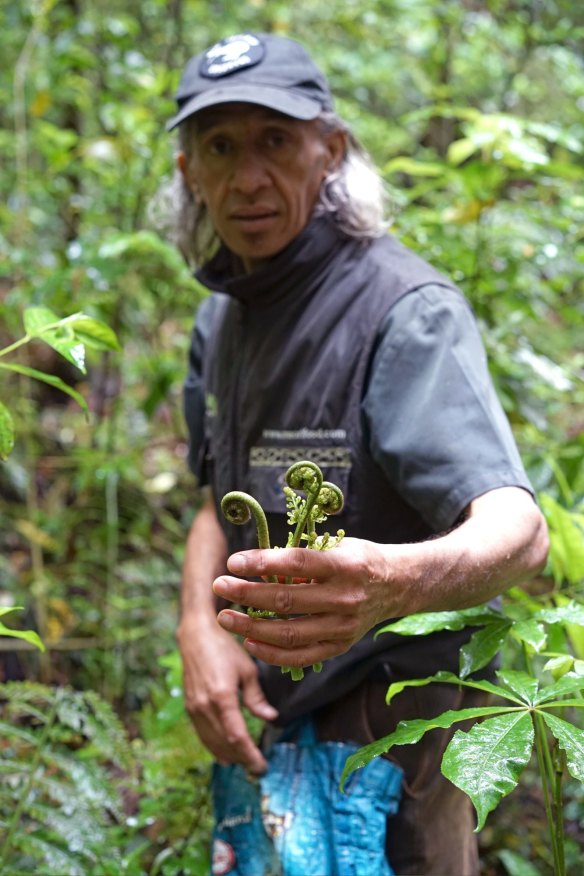Three unique New Zealand food experiences from hobbit banquets to hangi

Known for its active volcanoes, Maori history and a landscape that swings between farmland, forest and foreshore, New Zealand's North Island upholds its reputation for adventure. But look beyond Auckland's restaurants and Wellington's coffee culture and you'll find edible experiences you just can't come close can't having anywhere else in the world.
Eat like a Hobbit
You don't have to be a fan of The Hobbit or Lord of the Rings to appreciate the attention to detail at the Hobbiton movie set (a significant location used for The Lord of the Rings film trilogy and The Hobbit film series), located on a 506 hectare sheep farm in Matamata. From timber that is aged with vinegar to hollowed-out gourds used as birdhouses, food was used extensively behind the scenes. Eels hang at the fishmonger's house, wheels of cheese sit outside the cheesemonger's door and jars of honey line up in a row at the beekeeper's. But if you want to eat like a hobbit, take the Evening Banquet Tour.

I arrive at dusk alongside a busload of people from all over the world – one couple wearing custom hobbit t-shirts and others having never read the book nor seen the films. "No one has ever finished all the food on their table," says the woman at the sign-in desk, "We've had full rugby teams and no one's ever done it." Sounds like a challenge to me.
The standard tours have finished for the day, leaving the Shire to us. After a leisurely, fact-filled two-hour stroll past round doors built into hills accented by glowing lanterns and smoking chimneys, we pass the old mill and cross the Brandywine River to The Green Dragon Inn, just as Frodo and Gandalf do in The Fellowship of the Ring.
When the banquet tour launched in 2015, the menu and table setting was created in conjunction with set designers and art directors who worked on the films. At the big reveal, curtains are drawn to expose three long tables piled with food and props.
"It's not a very technical term," says Hobbiton food and beverage manager Mitch King, "but it's 'hobitty' food. It's probably best described as old English, traditional fare. We use a lot of local produce and it's a hearty meal. Hobbits eat a lot of food and so do our guests."
Wooden boards of roast chickens stabbed with carving knives, giant lamb shanks with meat falling from bone, slabs of smoked salmon, half pumpkins posing as bowls, bread rolls and vegetables, saucy Cumberland sausage, jugs of gravy, bowls of mash, bubble and squeak and more – and that's before cheese and dessert (perhaps neither Australians nor New Zealanders invented pavlova, but Hobbits?).
By the time belts are unbuttoned, I've made friends but barely a dint in the food.
The Evening Banquet Tour is one of the most popular offerings at Hobbiton and it always sells out, but it's worth checking regularly; some people in my group had filled cancellations. Quality of the food aside there is something truly magical about seeing the Shire blush at sunset – it feels as though the Hobbits have just popped out for a moment.
Hungry for Hangi
One of the most popular activities on tourist to-do lists in New Zealand is a hangi. Hangi cooking involves wrapping up food such as chicken, fish and root vegetables and cooking it in an underground pit. These days you're more likely to see wire baskets with the additions of lamb and stuffing lowered into the ground, where it can stay for hours.
The go-to hangi experience is tacked onto Maori village tours in Rotorua, which I find a little contrived. But the Tamaki Maori Village is my pick of the lot. Personally I prefer wandering around Whakarewarewa, the only living Maori village geared towards tourists. Aside from cultural shows, geothermal walks and a great way to see the Pohutu geyser without paying close to $50 at Te Puia, you can pop into the cafe and eat a hangi pie for less than $5 overlooking the geothermal area where the fillings are steamed. It's cheaper and tastier than the overpriced hangi packs with a hint of bain-marie.
But my hangi hunger still wasn't satiated. I decide to do a little digging and I found a hangi shop beside a Caltex, 15 kilometres down the Southern Highway from Auckland CBD.
The Hangi Shop was set up 18 years ago by Catherine Lim. With a Chinese father and a mother who's Maori, English and Indian, Lim grew up on different cuisines at the dinner table, but hangi meals were reserved for special occasions. Lim and her brother used to sell hangi packs at the Manurewa markets while their mother was at church. Her brother opened a hangi shop in 1997, and after the real estate office where she worked closed down, she opened another to pass onto her kids.
Lim uses special steamers in place of the traditional pit to keep up with demand and better control the cooking. For her, it's more picking the right produce, something she learned growing up on a farm – it's this freshness that's missing from more tourist-oriented hangi experiences.
"This is who I am, that's why I've been going so long," she says. "There's a market out here for this, but it's so important to be who you are, and to pass that onto your kids."
Forage with a Maori Chef
Charles Royal is not Charles Royal's real name. It's Pipitukukino Roera, and he can trace his Maori ancestors back 18 generations. He's not the hefty Maori stereotype but outdoorsy with wild grey hair tucked behind his ears and piko piko fern tattoos curling up them.
The middle child of three boys, Royal has always been interested in cooking and would spend his time in the kitchen with his mum. When army recruiters visited his school, Royal was 14 years old and looking for a way to skip class. His clubfeet meant he was bound for a trade instead of service, where he learned to cook for groups. From there he owned restaurants, but after realising that there were no Maori restaurants because no one could get Maori ingredients, he founded Kinaki Wild Herbs and became the supplier.
Today he's sharing his heritage with me. We're on a sliver of native forest out the back of his property in Lake Rotoma, half an hour's drive north east of Rotorua. Royal removes his black cap with its kiwi emblem and his karakia (prayer) to the Mother Earth and Sky Father reverberates through the bush. He turns to me, arms spread, and announces, "This is our garden. This is our kitchen."
Royal picks young, tightly curled piko piko fronds with the flick of a wrist, navigates snaking pirita (supplejack) to find the natural snapping point, picks mangeao leaves to lower blood sugar and scrapes old man's beard from branches to help manage his Type 1 diabetes. He steers clear of "gimmicky" huhu grubs, but if a client insists he always tells them it's Maori tradition for guests to eat the first one.
These bespoke, half-day foraging tours include a home cooked lunch and, whether permitting, perhaps a cook up by the lake or a dip in the hot pool and waterfall around the corner. Royal also consults to the Prince's Gate hotel in Rotorua, where you can sample native ingredients as part of a seven-course degustation. If you go foraging with Royal that day, the kitchen might even incorporate your haul.
"What I do, it reinforces culture. That's why I pass on knowledge," says Royal, "Now all our young ones are picking it up, that's the most pleasing part for me – seeing these young chefs saying, 'I can do that. I take it further'."
The writer travelled with assistance from Tourism New Zealand.
Restaurant reviews, news and the hottest openings served to your inbox.
Sign up